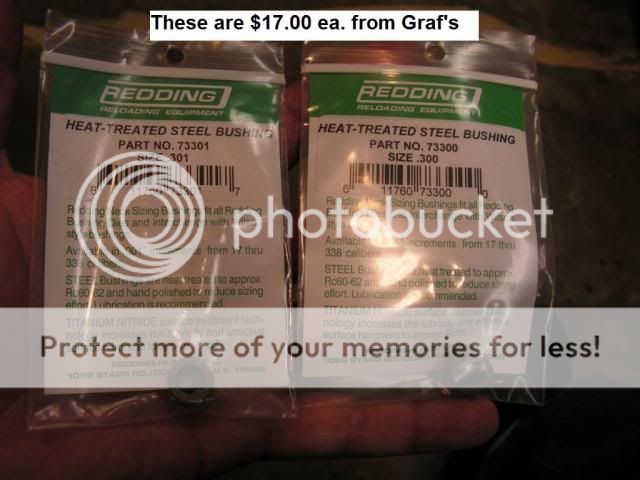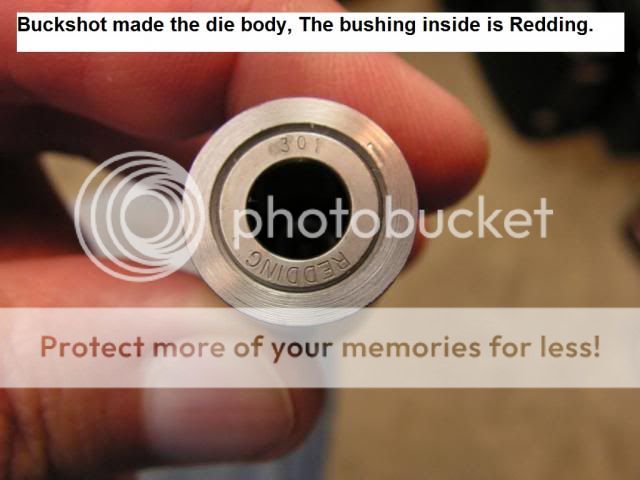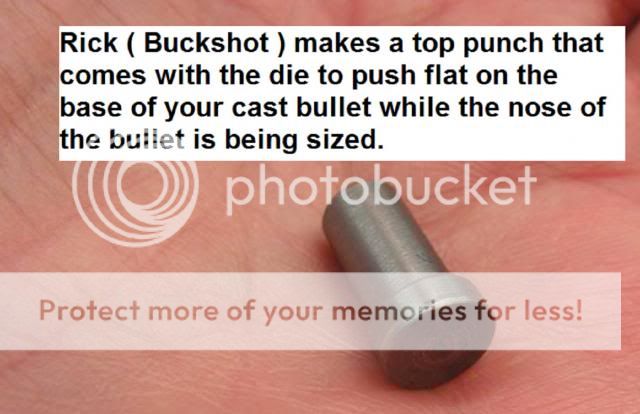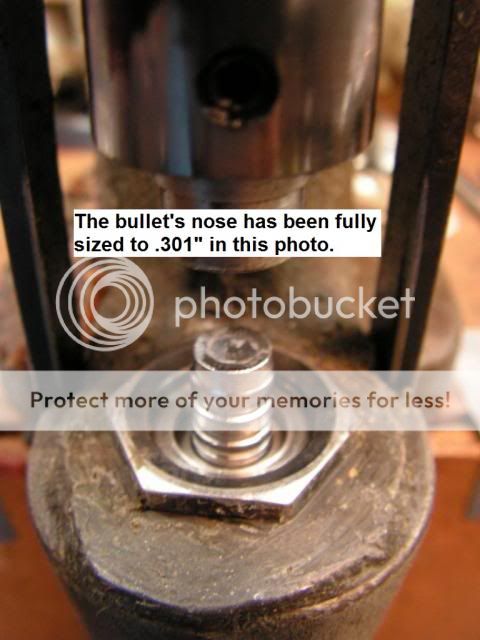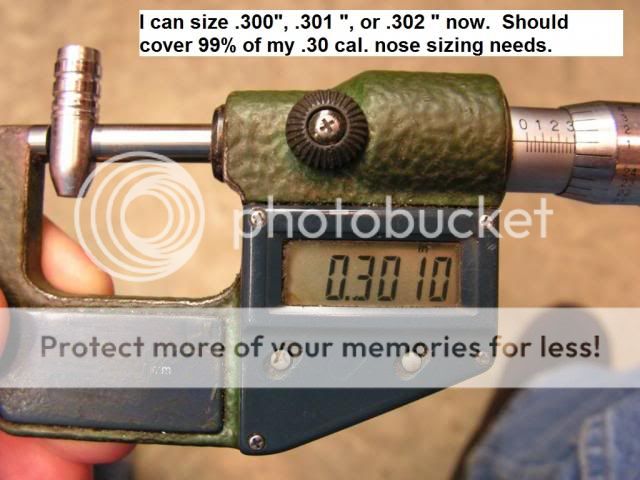All totally dependent upon whether the support system can remain centered during the rigors of launch, or not. Generally, such a system is good for pretty decent accuracy within the window of BHN/pressure that Richard Lee relates in Modern Reloading, 2nd ed., at least that is what I've found to be true over and over again.
When the rigors of launch surpass the ability of a weakly-guided bullet to remain straight during the transition into the rifling, then you get such notions as "rpm theory" or "stripping the rifling" theory or "35-bhn-to-accuracy" theory, which are nothing more than superstitious explanations for poor cartridge fitment techniques and improper powder/alloy matches.
Here's a perfect example of what I mean: Rifle is a .308 Winchester bolt-action with 20" bull barrel and a SAAMI-spec chamber and throat. First loads are with Unique and 2400 powder, no filler, 311041 (actually a Lee group buy copy that's even better). Using factory Federal brass, fireformed and neck sized, accuracy was in the 1" range for ten shots at 100 yards, sometimes better depending on the exact charge of powder. Unlike longer, thinner barrels this rifle didn't exhibit huge swings in group shape and size with the .2-grain increments workup with Unique. Unique got up to about 1450 fps before groups started going away, right where the Lee formula would indicate. 2400 got to almost 1700 fps before groups fell apart. Reloder 7 didn't shoot well at all with that bullet or alloy, so WW748 was tried and I managed to achieve about 1900 fps with the bullet and alloy before groups fell apart. Now, at that point, using conventional fitment, alloy, and loading methods, I was stuck. I tried every which way from Sunday to keep groups under an inch and go faster, it just wasn't going to happen I tried water-quenched bullets, some harder alloy, much slower powders, on and on, no dice. Some would say that I had reached the limit of my system due to the "rpm threshold" of a ten-twist .30 caliber rifle. So what was REALLY going on? I asked myself. Well, take a look at the system. Factory brass leaves .006" all around the case neck in the chamber with .310" bullets. At launch pressures that push the bullet beyond 1900 fps, something could be going wrong there. So I proceed to make some cases out of military blank brass which have really thick necks. I got the chamber neck clearance down to a thousandth of an inch total. I was able to get a little more velocity and still achieve my MOA goal, but really about 2100 fps was it. There are a lot of holes in my notes and memory at this point as my experimentation outpaced my interest in keeping notes, but the gist is that the bullet, even though it lightly engraved the rifling, had an intermediate band that touched the tapered part of the leade, and was sized to throat entrance diameter and further was supported with virtually no clearance in the chamber neck, wasn't getting the job done any more. So I switched bullets and tried several, two of which ultimately worked. One was one of my own design, the Accurate 30-185G, and the other, the MP 30 Silhouette which is a proven high-velocity shooter IF you know what you are doing. When I first tried the MP bullet, at 2100 fps, I was getting scattergun groups, it was terrible. After trying a variety of powders I finally switched alloy and started using a 21 bhn version of mixed WW/pure with 1% tin (later I discovered the tin addition was a mistake). Long story short, I was able to get into the 22s with accuracy using H335 and 748, but NOT using 3031 or 4320. Hmmm, single-base powders were a no-go, interesting. So on to H4350 I went and groups blew up again. Finally, I switched to H414 and was able to get my system up to nearly 2400 fps with repeatable, MOA accuracy. Just for grins, I switched back to Federal brass and groups went to hell again. I tried just changing alloy to water-quenched WW and groups again fell apart. I tried air-cooled WW + 2% tin and not only did groups fall apart, but I got some leading. The only thing I didn't test that I should have was the 311041 cast of water-quenched 50/50 alloy with my otherwise successful 2380 fps load of H414 and blank brass. Also, I haven't gotten the 30 Silhouette bullet to shoot any better than the 311041 at much lower velocities using Unique, but I'm sure that's just a matter of not having spent the time to learn what alloy would have worked best with that bullet, chamber, and powder combination.
So what was going on? Really, it comes down to controlling bullet deformation. At a certain point, about 1900-2000 fps, you have to go to a really hard alloy to keep your accuracy because the bullet is starting to deform in unwanted ways at those pressures, AND the twist rate of the gun is spinning the bullet fast enough that those balance defects start to really show up (rpm theory). But just making the bullet harder and harder to resist deformation isn't the full solution here, so a totally different approach is necessary: Work WITH the deformation, rather than fight against it. This is where most people go wrong with their approach and thinking. A lead bullet that's hard enough to resist deformation from poor fit when launched at 2400 fps has a host of other problems associated with being too hard, and those affect accuracy. Slip-stop in the bore, lack of abrasion resistance (micro-flaking causing excess antimony wash/leading), cracking and brittleness, and lack of ability to flex and soak up inconsistencies in the barrel all contribute to erratic barrel time and the Harmonics Monster gets you. The answer, I found, is to find a bullet shape which WILL deform, but do so in a controlled and guided manner, and go ahead and deform it with a powder that does just enough, but not too much "bumping". H414 at 23-2400 fps in a .308 happened to be the right stuff to push the .30 Silhouette into the throat gently enough to allow it to self-center, and bump it hard enough as it engraved to keep it sealed and perfectly conforming to the barrel as it made the transition to the rifling, and the alloy was tough yet flexible enough to make the trip through the barrel smoothly and repeatably without sloughing off bits of alloy everywhere like Linotype and other hard alloy compositions are wont to do. This works just one way, change one thing a little and it falls apart. Many will say what I did was impossible because they haven't taken the time to learn just what combinations work themselves, only try a few things without knowledge of what they need to achieve and give up when all they get are scattergun groups.
Once I learned a little bit about fit, alloy, and pressure curve and started getting better results at well above the "normal" velocities associated with cast bullets, it became difficult for me to reverse-think back to conventional, two-parallel-diameter bullets and focusing on bore and groove diameter as fitment criteria. That method works up to a point, but really it has a lot of limitations. Even the CBA guys, at modest velocities, do not use the "two dimensional" bullet fit concept because it will not achieve competitive accuracy. Those fellows are precisely fitting their bullets to match throat shape, and are putting as little of the bullet in the case neck as they can. They generally use very hard bullets, too, but are keeping them down in the velocity range where sloughing isn't really a problem.










